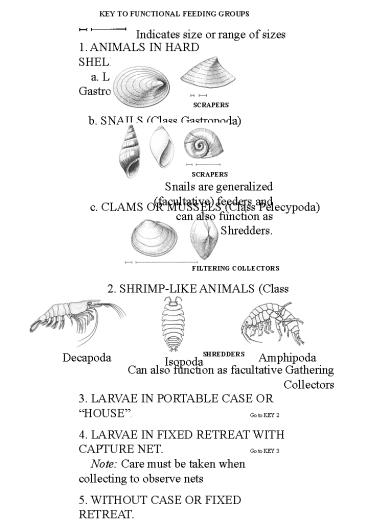Facultative Feeding Groups - PowerPoint PPT Presentation
1 / 5
Title:
Facultative Feeding Groups
Description:
Leaf, stick, needle, bark. CASES MINERAL. Sand, fine gravel. Cases square in cross section ... considers some fairly common insects that do not fit in ... – PowerPoint PPT presentation
Number of Views:82
Avg rating:3.0/5.0
Title: Facultative Feeding Groups
1
KEY TO FUNCTIONAL FEEDING GROUPS
Indicates size or range of sizes
1. ANIMALS IN HARD SHELL (Phylum Mollusca) a.
LIMPETS (Class Gastropoda)
SCRAPERS
b. SNAILS (Class Gastropoda)
SCRAPERS
Snails are generalized (facultative) feeders and
can also function as Shredders.
c. CLAMS OR MUSSELS (Class Pelecypoda)
FILTERING COLLECTORS
2. SHRIMP-LIKE ANIMALS (Class
Crustacea)
SHREDDERS
Decapoda
Amphipoda
Isopoda
Can also function as facultative Gathering
Collectors
3. LARVAE IN PORTABLE CASE OR HOUSE. Go to KEY
2 4. LARVAE IN FIXED RETREAT WITH CAPTURE NET.
Go to KEY 3 Note Care must be taken when
collecting to observe nets 5. WITHOUT CASE OR
FIXED RETREAT. a. WORM-LIKE LARVAE, WITHOUT
JOINTED LEGS. Go to KEY 4 b. NYMPHS OR
ADULTS WITH JOINTED LEGS. Go to KEY 5 6. DOES
NOT FIT KEY 5 EXACTLY. Go to KEY 6 or KEY 7
2
KEY 2 FIRST LEVEL OF RESOLUTION
LARVAE IN PORTABLE CASE Caddisflies (Order
Trichoptera)
CASES, ORGANIC Leaf, stick, needle, bark
CASES MINERAL Sand, fine gravel
Families Limnephilidae (in part)
Lepidostomatideae (in part) Phyrganeidae,
Leptoceridae (in part)
Families Glossosomatidae, Limnephilidae (in
part), Helicopsychidae
SHREDDERS
SCRAPERS
SECOND LEVEL OF RESOLUTION considers a few fairly
common caddisflies that would be misclassified
above on the basis of case composition alone.
CASES ORGANIC
CASES MINERAL
Cases square in cross section and tapered, with
no bark or flat leaf pieces included. Front
attached to substrate. Larvae extend legs
and filter the current
Cases long, slender and tapered, made of plant
material
Cases long, slender and tapered (mostly fine
sand) or cases ovoid and very flat in cross
section
Family Brachycentridae(in part)
Family Leptoceridae (in part)
Family Leptoceridae (in part)
GATHERING COLLECTORS
FILTERING COLLECTORS
GATHERING COLLECTORS
3
KEY 3
FIRST LEVEL OF RESOLUTION
LARVAE WITH FIXED RETREAT AND CAPTURE NET
Note Care must be taken when collecting to
observe nets.
True Flies (Order Diptera)
Caddisflies (Order Trichoptera)
COURSE NET IN SCAFFOLDING
FLATTENED SOCK-LIKE OR TRUMPET-SHAPED NET OF FINE
MESH
TUBE WITH SILK STRANDS STRUNG BETWEEN TERMINAL
PRONGS
True Midges (Family Chironomidae)
Families Hydropsychidae, Philopotamidae,
Polycentropodidae
FILTERING COLLECTORS
SECOND LEVEL OF RESOLUTION separates from free
living larvae those net spinning caddisflies that
may have been inadvertently collected without
being associated with their nets.
NET SPINNING CADDISFLIES Frequently separated
from their nets
FREE LIVING CADDISFLIES Non net spinning
HEAD AS WIDE AS THORAX
HEAD LONG, SMALL, AND NARROWER THAN THORAX
Especially Philopotamidae (bright yellow) and
Hydropsychidae (bright green or brown)
Rhyacophilidae (often bright green)
FILTERING COLLECTORS
PREDATORS
4
KEY 4
FIRST LEVEL OF RESOLUTION
WORM-LIKE LARVAE WITHOUT JOINTED LEGS
LARGE
SMALL
Larger than
smaller than
Head retractile and poorly developed Caudal lobes
with eye-like spiracles
BOWLING PIN SHAPE Bulbous base usually fastened
tightly to substrate
LONG AND SLENDER
Craneflies (Family Tipulidae (in part)
SHREDDERS
True Midges (Family Chironomidae) Note Subtract
10 of count for Predators
Blackflies (Family Simuliidae)
GATHERING COLLECTORS
FILTERING COLLECTORS
SECOND LEVEL OF RESOLUTION considers some
worm-like Predators that would be misclassified
in the above key.
WORM-LIKE LARVAE WITHOUT JOINTED LEGS
SMALL
LARGE
Prolegs poorly developed or absent jaws well
developed very active
Prolegs along entire length Head visible
Posterior segment swollen Head retractile
Family Tipulidae (Dicranota type)
Family Tipulidae (Eriocera type)
Family Athericidae
PREDATORS
5
KEY 7
SECOND LEVEL OF RESOLUTION considers some fairly
common insects that do not fit in the above key
or would be misclassified on the basis of body
shape alone.
NYMPHS AND ADULTS WITH BEAK AND HEMELYTRA
Beak triangular front legs smaller
Sharp beak, front legs large
Family Naucoridae
Family Corixidae
SCRAPERS
Family Belostomatidae
PREDATORS































